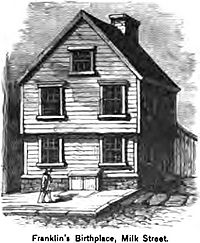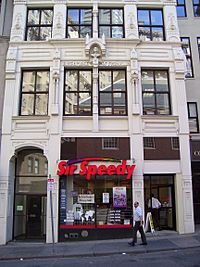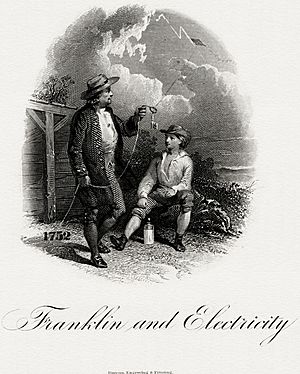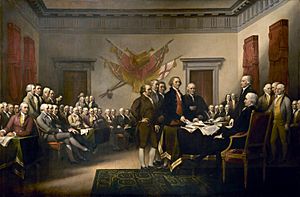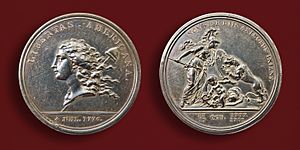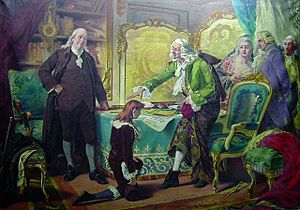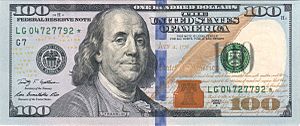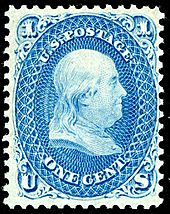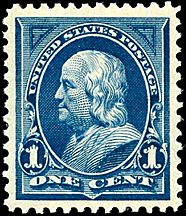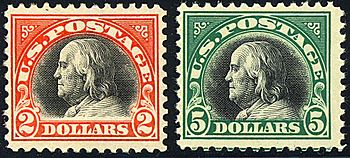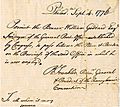Benjamin Franklin facts for kids
Quick facts for kids
Benjamin Franklin
|
|
|---|---|
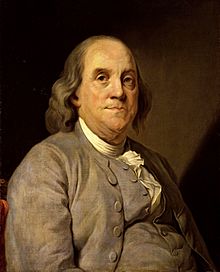 |
|
| 6th President of Pennsylvania | |
| In office October 18, 1785 – November 5, 1788 |
|
| Vice President | Charles Biddle Thomas Mifflin |
| Preceded by | John Dickinson |
| Succeeded by | Thomas Mifflin |
| United States Minister to France | |
| In office September 14, 1778 – May 17, 1785 Serving with Arthur Lee, Silas Deane, and John Adams
|
|
| Appointed by | Continental Congress |
| Preceded by | New office |
| Succeeded by | Thomas Jefferson |
| United States Minister to Sweden | |
| In office September 28, 1782 – April 3, 1783 |
|
| Appointed by | Congress of the Confederation |
| Preceded by | New office |
| Succeeded by | Jonathan Russell |
| 1st United States Postmaster General | |
| In office July 26, 1775 – November 7, 1776 |
|
| Appointed by | Continental Congress |
| Preceded by | New office |
| Succeeded by | Richard Bache |
| Speaker of the Pennsylvania Assembly | |
| In office May 1764 – October 1764 |
|
| Preceded by | Isaac Norris |
| Succeeded by | Isaac Norris |
| Member of the Pennsylvania Assembly | |
| In office 1762–1764 |
|
| In office 1751–1757 |
|
| Personal details | |
| Born | 100px January 17, 1706 Boston, Massachusetts Bay |
| Died | April 17, 1790 (aged 84) Philadelphia, Pennsylvania |
| Resting place | 100px |
| Nationality | American |
| Political party | Independent |
| Spouse | Deborah Read |
| Children | William Franklin Francis Folger Franklin Sarah Franklin Bache |
| Parent |
|
| Profession | Scientist Writer Politician |
| Signature |  |
Benjamin Franklin (January 17, 1706 – April 17, 1790) was an amazing American who did many things. He was a writer, scientist, inventor, and a very important politician. He was also a diplomat, printer, and publisher.
Franklin was one of the Founding Fathers of the United States. He helped write and sign the Declaration of Independence. He was also the first Postmaster General for the U.S. You can see his picture on the $100 bill. Many places, like towns and schools, are named after him.
As a scientist, Franklin was famous for studying electricity. He also mapped and named the Gulf Stream current. As an inventor, he created the lightning rod, bifocals (glasses with two different strengths), and the Franklin stove. He started many important groups, like the Library Company and Philadelphia's first fire department. He also helped start the University of Pennsylvania. People called him "The First American" because he worked hard to unite the colonies.
Franklin wrote or received over 30,000 letters and documents. These have been collected in The Papers of Benjamin Franklin.
Contents
- Benjamin Franklin's Early Life and Education
- Benjamin Franklin as a Newspaperman
- Benjamin Franklin's Inventions and Science Discoveries
- Benjamin Franklin's Musical Interests
- Benjamin Franklin's Public Life and Politics
- Benjamin Franklin's Beliefs and Virtues
- Benjamin Franklin and Slavery
- Benjamin Franklin's Hobbies and Activities
- Benjamin Franklin's Death and Legacy
- Benjamin Franklin on U.S. Postage Stamps
- Benjamin Franklin's Family Life
- Places and Things Named After Benjamin Franklin
- Interesting Facts About Benjamin Franklin
- Benjamin Franklin's Famous Quotes
- Images for kids
- See also
Benjamin Franklin's Early Life and Education
Benjamin Franklin's father, Josiah Franklin, made soap and candles. His mother, Abiah Folger, came from a Puritan family. They were among the first Pilgrims who came to Massachusetts for religious freedom.
Benjamin was born in Boston on January 17, 1706. He was the 15th of his father's 17 children. As a child, he was often the leader among his friends.
Franklin's father could only afford to send him to school for two years. He went to Boston Latin School but stopped when he was ten. He worked for his father for a while. At age 12, he became an apprentice to his brother James, who was a printer. Benjamin learned the printing business from him.
When Benjamin was 15, his brother James started The New-England Courant, a newspaper. Benjamin wanted to write for the paper but was not allowed. So, he secretly wrote letters using the name "Silence Dogood". These letters were very popular. James was not happy when he found out his younger brother was the famous writer. Franklin believed in free speech from a young age. When his brother was put in jail for three weeks for printing something the governor didn't like, young Benjamin took over the newspaper.
Franklin left his apprenticeship without his brother's permission. At 17, he moved to Philadelphia to start fresh. He worked in several printing shops there. Later, the governor of Pennsylvania, Sir William Keith, convinced him to go to London. Franklin worked as a typesetter in a printer's shop in London. In 1726, he returned to Philadelphia and worked for a merchant named Thomas Denham.
In 1727, when he was 21, Franklin started a group called the Junto. It was a discussion group for people who wanted to improve themselves and their community. They talked about important issues of the day.
Reading was very important to the Junto members, but books were expensive. Franklin came up with the idea of a subscription library. Members would pay money together to buy books for everyone to read. This was the start of the Library Company of Philadelphia, America's first lending library.
Benjamin Franklin as a Newspaperman
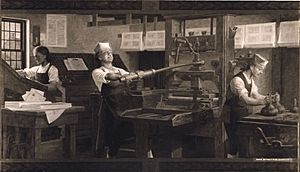
In 1728, Franklin opened his own printing business. The next year, he became the publisher of The Pennsylvania Gazette, a newspaper in Philadelphia.
In 1732, he started the first German-language newspaper in America, Die Philadelphische Zeitung. However, it only lasted one year because other German papers quickly became more popular.
Over the years, Franklin helped many other printers start their businesses. By 1753, he or his partners published 8 out of 15 English newspapers in the colonies. Franklin became very wealthy and well-known as a printer, publisher, and writer. Later, he sold his businesses to focus on science and politics.
Franklin's Success as an Author
In 1733, Franklin began writing Poor Richard's Almanack under the name Richard Saunders. This almanac contained many wise sayings and became very popular.
In 1758, he published Father Abraham's Sermon, also known as The Way to Wealth. Franklin's autobiography, which he started in 1771, is a famous book about his life.
Benjamin Franklin's Inventions and Science Discoveries
Franklin was a brilliant inventor. He created the lightning rod, the glass harmonica (a musical instrument made of glass), the Franklin stove, and bifocal glasses. He also invented a flexible urinary catheter. He never patented his inventions. He believed that since we benefit from others' inventions, we should share our own freely.
Franklin's Electricity Experiments
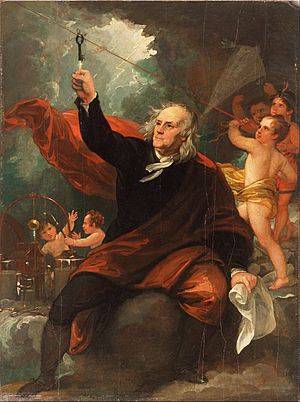
Franklin began studying electricity in 1746.
Kite Experiment and Lightning Rod
In 1750, Franklin suggested an experiment to prove that lightning is electricity. This experiment involved flying a kite in a storm. On May 10, 1752, a French scientist named Thomas-François Dalibard did Franklin's experiment using a 40-foot iron rod. He successfully got electrical sparks from a cloud.
On June 15, 1752, Franklin might have done his famous kite experiment in Philadelphia. He successfully got sparks from a cloud. He wrote about the experiment in his newspaper, The Pennsylvania Gazette, on October 19, 1752. Franklin was careful to stay safe by standing under a roof and keeping dry. Other people who tried similar experiments without caution were sadly electrocuted.
Franklin knew the dangers of lightning. He showed that lightning was electrical by collecting a small electric charge from a storm cloud. He did not stand in the open waiting to be struck.
Franklin's electricity experiments led to his invention of the lightning rod. He discovered that sharp metal points could silently draw off electricity from a distance. He suggested putting sharp iron rods on buildings, with a wire going into the ground. This would protect buildings from lightning strikes. Lightning rods were installed on the Academy of Philadelphia (now the University of Pennsylvania) and the Pennsylvania State House (now Independence Hall) in 1752.
Franklin's Oceanography Findings
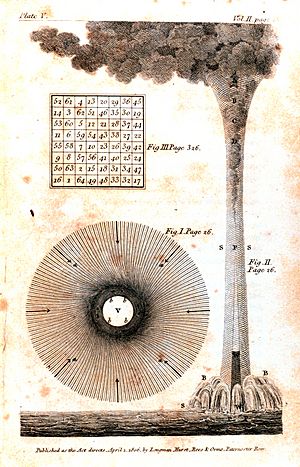
Franklin gathered all his discoveries about the ocean in a paper called Maritime Observations in 1786. It included ideas for sea anchors, catamaran hulls, watertight compartments, and lightning rods for ships. He even designed a soup bowl that would stay steady in stormy weather!
Franklin's Decision-Making Method
In a letter from 1772, Franklin described a simple way to make decisions. It's called the Pro & Con list, or a decisional balance sheet. You list all the good points (pros) and bad points (cons) of a decision to help you choose.
Oil on Water
Franklin noticed that when cooks threw greasy water overboard, it calmed the ship's wake. He experimented with this on a pond in London. He found that even a tiny bit of oil could calm a large area of water. He later carried a little oil in his cane to "calm the waters" when needed.
Benjamin Franklin's Musical Interests
Franklin played the violin, harp, and guitar. He also wrote music, including a string quartet. He greatly improved the glass harmonica. In his version, the glass bowls spun on a rod while the player held their fingers still. This new design became popular in Europe. Famous composers like Mozart and Beethoven wrote music for Franklin's glass harmonica.
Benjamin Franklin's Public Life and Politics
Early Steps in Politics
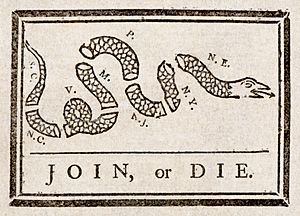
Franklin quickly became involved in Philadelphia politics. In 1748, he became a councilman. In 1749, he became a Justice of the Peace. In 1751, he was elected to the Pennsylvania Assembly.
On August 10, 1753, Franklin was made deputy postmaster-general of British North America. He greatly improved the postal system, making mail delivery weekly.
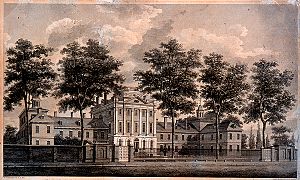
In 1751, Franklin and Dr. Thomas Bond helped create the Pennsylvania Hospital. It was the first hospital in what would become the United States.
Franklin also helped shape American colleges. He believed in teaching practical skills and using English instead of Latin. He also thought professors should be experts in their subjects. The college he helped create, the College of Philadelphia, later became the University of Pennsylvania. Many people from this college helped write the Declaration of Independence.
In 1753, both Harvard and Yale gave him honorary degrees. In 1754, he led the Pennsylvania group at the Albany Congress.
Declaration of Independence
When Franklin returned to Philadelphia in May 1775, the American Revolution had already started. The fighting between the colonists and the British had begun. The Pennsylvania Assembly chose Franklin to represent them at the Second Continental Congress.
In June 1776, he was chosen for the Committee of Five that wrote the Declaration of Independence. Even though he was sick with gout and missed some meetings, Franklin made important changes to the draft written by Thomas Jefferson.
At the signing of the Declaration, John Hancock said they must all stick together. Franklin famously replied, "Yes, we must, indeed, all hang together, or most assuredly we shall all hang separately."
Franklin as Postmaster General
-

Benjamin Franklin
First US postage stamp
Issue of 1847
Franklin was appointed postmaster of Philadelphia in 1737. In 1753, he became deputy postmaster-general of British North America.
On July 26, 1775, the Second Continental Congress created the United States Post Office. They named Benjamin Franklin as the first United States Postmaster General. He had a lot of experience and was the perfect choice. He set up a postal system that is still used today.
Ambassador to France: 1776–1785
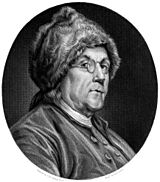
In December 1776, Franklin was sent to France as a commissioner for the United States. He worked to get France to support the American Revolution.
While in France, Franklin was also active in Freemasonry. He was a leader in the Lodge Les Neuf Sœurs.
Franklin also pushed for religious tolerance in France. His efforts helped lead to King Louis XVI signing the Edict of Versailles in 1787. This law gave non-Catholics civil rights and the freedom to practice their faith.
Franklin also served as the American minister to Sweden, but he never visited that country.
President of Pennsylvania
On October 18, 1785, Benjamin Franklin was chosen as the sixth president of Pennsylvania. He replaced John Dickinson.
Benjamin Franklin's Beliefs and Virtues
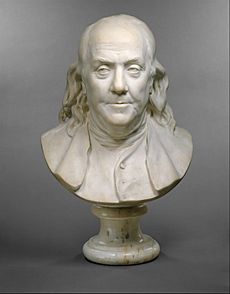
Franklin believed that a new republic could only succeed if its people were good and honest. He spent his life exploring the importance of good character. He felt that organized religion helped people be good to each other, but he didn't often attend religious services himself.
Franklin's Thirteen Virtues
Franklin tried to improve his character by following 13 virtues. He created this plan when he was 20 (in 1726) and used it for the rest of his life. His autobiography lists his 13 virtues:
- Temperance: Don't eat or drink too much.
- Silence: Only speak if it helps others or yourself. Avoid silly talk.
- Order: Keep your things in their place. Do your tasks at the right time.
- Resolution: Decide to do what you should, and then do it without fail.
- Frugality: Don't spend money unless it helps others or yourself. Don't waste anything.
- Industry: Don't waste time. Always be doing something useful. Avoid unnecessary actions.
- Sincerity: Don't lie in a harmful way. Think honestly and fairly, and speak that way too.
- Justice: Don't hurt anyone. Don't fail to do good things that are your duty.
- Moderation: Avoid extremes. Don't get too angry about injuries.
- Cleanliness: Keep your body, clothes, and home clean.
- Tranquility: Don't be bothered by small things or accidents that are normal or can't be avoided.
- Chastity
- Humility: Try to be like Jesus and Socrates.
Benjamin Franklin and Slavery
When Franklin was young, slavery was common in the British colonies. In his later years, Franklin wrote many essays about the importance of ending slavery. He also wrote about helping Black people become part of American society.
Benjamin Franklin's Hobbies and Activities
Chess
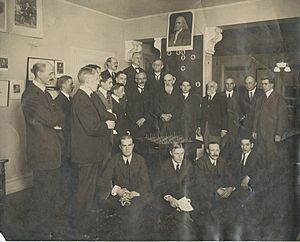
Franklin loved playing chess. He started playing around 1733, making him the first known chess player in the American colonies. His essay "The Morals of Chess" from 1786 is the second known writing about chess in America. This essay praised chess and suggested good behavior for the game. It has been printed many times. He even used chess to learn Italian with a friend. The winner would assign the loser a task, like memorizing Italian grammar.
Franklin played chess more often in England and France, where the game was more popular. He went to coffee houses in London and the famous Café de la Régence in Paris to play and meet people. We don't have records of his games, so we don't know how strong a player he was.
Franklin was added to the U.S. Chess Hall of Fame in 1999. The Franklin Mercantile Chess Club in Philadelphia is named after him.
Benjamin Franklin's Death and Legacy
Benjamin Franklin passed away at his home in Philadelphia on April 17, 1790, at age 84. About 20,000 people attended his funeral. He was buried in Christ Church Burial Ground in Philadelphia.
Franklin signed both the Declaration of Independence and the Constitution. He is considered one of the Founding Fathers of the United States. People sometimes jokingly call him "the only President of the United States who was never President of the United States."
Since 1928, Franklin's picture has been on American $100 bills. These bills are sometimes called "Benjamins" or "Franklins." From 1948 to 1963, his portrait was on the half dollar. He has also appeared on other bills. The city of Philadelphia has about 5,000 images of Benjamin Franklin. The Benjamin Franklin Parkway and Benjamin Franklin Bridge in Philadelphia are named after him.
In 1976, a 20-foot marble statue of Franklin was dedicated at the Franklin Institute in Philadelphia. This is the Benjamin Franklin National Memorial. Many of Franklin's personal items are also on display there.
In London, his house at 36 Craven Street is the only one of his former homes still standing. It is now open to the public as the Benjamin Franklin House.
Benjamin Franklin on U.S. Postage Stamps
Benjamin Franklin is a very important person in American history. He is honored on U.S. postage stamps many times. His image appears on U.S. postage more than any other American, except George Washington.
Franklin was on the first U.S. postage stamp, issued in 1847. From 1908 to 1923, he was featured on the Washington-Franklin Issues series of stamps for 14 years. He has also appeared on a few commemorative stamps.
Benjamin Franklin's Family Life
When Franklin was 17, he proposed to 15-year-old Deborah Read. Her mother was worried because Franklin was going to London and didn't have much money. While Franklin was in London, Deborah married another man. This marriage didn't work out, and her husband left her. Because of old laws, Deborah couldn't legally remarry.
Franklin and Deborah started living together as a couple on September 1, 1730. They raised Franklin's young son, William Franklin, together. They also had two children of their own. Their son, Francis Folger Franklin, was born in 1732 but sadly died of smallpox in 1736. Their daughter, Sarah "Sally" Franklin, was born in 1743.
Deborah was afraid of the sea, so she never went with Franklin on his long trips to Europe. Deborah Read Franklin died in 1774 while Franklin was in Great Britain. He returned in 1775.
William Franklin, Benjamin's Son
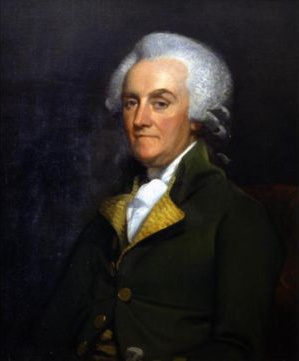
In 1730, Benjamin Franklin publicly accepted his son William and raised him. William was born on February 22, 1730. He studied law in London.
William Franklin remained loyal to the King during the American Revolutionary War. This caused a big disagreement between him and his father, Benjamin. William was put under house arrest in New Jersey in 1776. After the Declaration of Independence, he was jailed in Connecticut for two years. When he was released in 1778, he moved to New York City, which the British controlled.
In New York City, William led a group of Loyalists. When British troops left New York, William Franklin went with them to England. He settled in London and never returned to North America.
Places and Things Named After Benjamin Franklin
Many places and things are named after Benjamin Franklin because he was a Founding Father. Some of these include:
- The State of Franklin, a short-lived state during the American Revolution.
- Counties in at least 16 U.S. states.
- Several major landmarks in and around Philadelphia, Pennsylvania, where Franklin lived for a long time:
- Franklin and Marshall College in nearby Lancaster.
- Franklin Field, a football stadium.
- The Franklin Mercantile Chess Club in Philadelphia.
- The Benjamin Franklin Bridge across the Delaware River.
- The Franklin Institute, a science museum in Philadelphia.
- The Sons of Ben soccer supporters club.
- Ben Franklin Stores, a chain of variety stores.
- Franklin Templeton Investments, an investment company.
- The Ben Franklin effect in psychology.
- Benjamin Franklin Shibe, a baseball executive.
- Fictional characters like Benjamin Franklin "Hawkeye" Pierce from M*A*S*H and Benjamin Franklin Gates from National Treasure films.
- Franklinia alatamaha, a tree named after him.
- CMA CGM Benjamin Franklin, a large container ship.
- USS Franklin (CV-13), an aircraft carrier from World War II.
Interesting Facts About Benjamin Franklin
- Benjamin Franklin was the 15th child in his family.
- He only went to school for about two years. He mostly taught himself.
- In 1775, he built an early odometer for his carriage. It measured how far he traveled by counting wheel rotations.
- Benjamin Franklin and Alexander Hamilton are the only people who were not Presidents to be on U.S. currency. Franklin is on the $100 bill, and Hamilton is on the $10 bill.
- When he was 16, he stopped eating meat and was a vegetarian for a while.
Benjamin Franklin's Famous Quotes
- “Love your Enemies, for they tell you your Faults.”
- “Better slip with foot than tongue.”
- “Look before, or you’ll find yourself behind.”
- “Don’t throw stones at your neighbors, if your own windows are glass.”
- “Well done is better than well said.”
- “What you seem to be, be really.”
- “A true Friend is the best Possession.”
- “Haste makes Waste.”
- “Wish not so much to live long as to live well.”
- “Never ruin an apology with an excuse.”
Images for kids
-
Benjamin Franklin (center) at work on a printing press.
-
William Franklin (1730-1813), son of Benjamin Franklin.
-
Franklin's return to Philadelphia, 1785, by Jean Leon Gerome Ferris.
-
Gouverneur Morris signs the Constitution. Franklin is behind Morris. Painting by Hintermeister, 1925.
-
Franklin bust in the Archives Department of Columbia University.
-
Marble memorial statue, Benjamin Franklin National Memorial.
See also
 In Spanish: Benjamin Franklin para niños
In Spanish: Benjamin Franklin para niños


